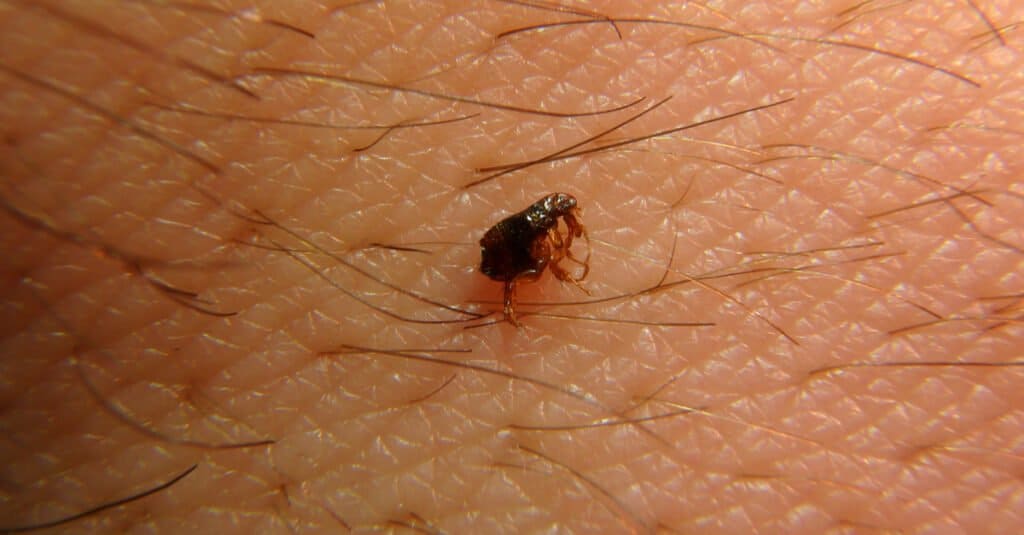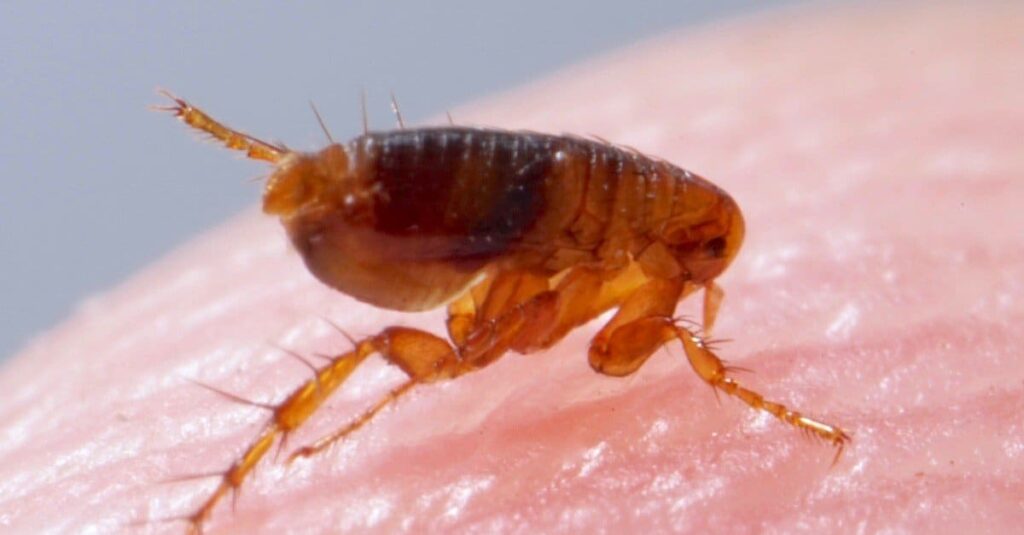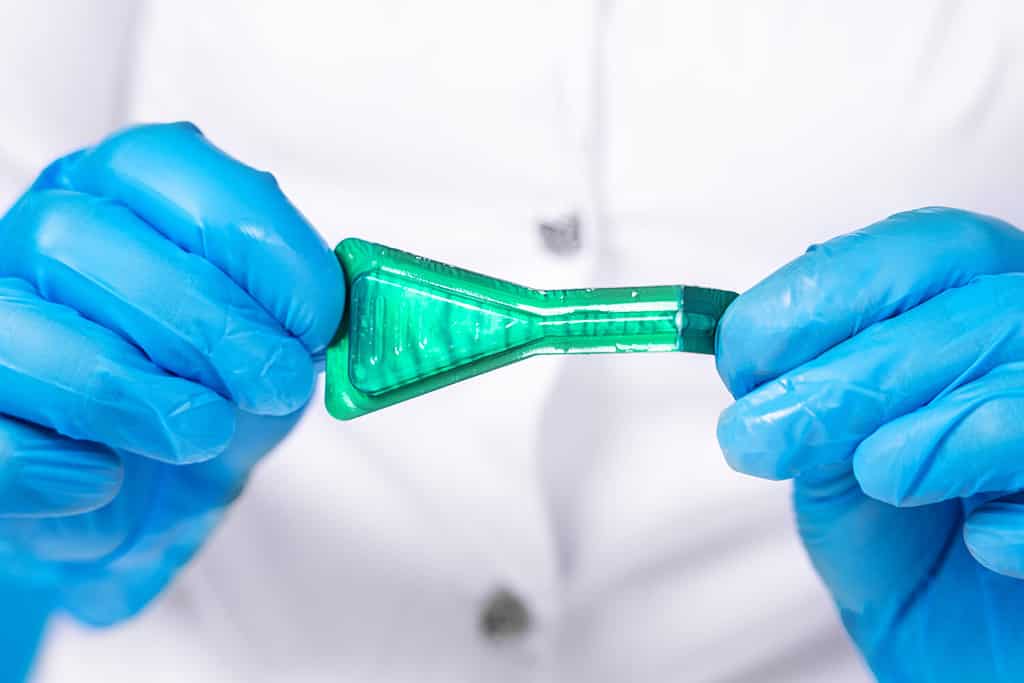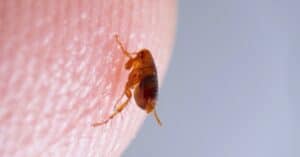If you have pets, you know the dreadful feeling of finding a flea on one of them. Fleas are parasites that spread and multiply quickly on animals. They also can live in fabric and carpets for a limited time as long as there are live animals around to feed off of. Flea bites are annoying and something that no pet owner wants to deal with. Keep reading to learn about what flea bites look like, how they feel, and how to treat them.

Fleas will feed off of animals or humans.
©David Jara Bogunya/Shutterstock.com
What Are Fleas?
Fleas are tiny insects that live off of blood. They can drink animal or human blood but are typically found on pets and other live animals. They are most prominent during the warmer months, typically July through October outdoors. However, they can live year-round indoors as long as they have a host.
There are more than 2,000 species of fleas in the world. In North America, the most common type of flea is the cat flea or Ctenocephalides felis. Most animals with fleas in North America are infected with cat fleas, even if they are dogs or other species.
Adult fleas are around ⅛ of an inch long and are red, brown, or mixed in color. They are wingless creatures that move around by crawling or jumping. In fact, fleas can jump up to 7 inches vertically and up to 13 inches horizontally.
Fleas reproduce quickly by laying eggs. Mature females lay 15 to 20 eggs daily, adding up to around 600 in their lifetime. Their eggs are ovular and white, and they stick to the hairs of animals. It is hard to remove flea eggs from the coat of an animal. When the eggs hatch, flea larvae come out. Larvae are worm-like and nearly translucent, until adulthood they are blind and legless. As larvae, they consume debris that they find on the host animal. Adult fleas consume extra blood and leave it on the host animal’s coat for larvae to find and eat. It takes a few weeks to months for larvae to grow into adult fleas and begin reproducing.

Fleas are around 1/16th of an inch long and can jump around 150 times their height.
©Sahara Frost/Shutterstock.com
What Does a Flea Bite Look and Feel Like?
On humans, flea bites look like small red dots. They usually show up in clusters and cause redness around them. If you’re bitten by a flea, it’s likely that you’ll notice right away. While flea bites aren’t as painful as ant bites, their bites are similar to a bite from a no-see-um. Sometimes you’ll see the flea that is biting you, but they may quickly jump away after biting. This can make it a bit harder to identify exactly what is biting you. A good way to check is by looking at your animals to see if there are fleas or bites on their skin. Check under their bellies and around their ears, where most fleas will hide.
Unfortunately, by the time a flea bites you, there are probably hundreds to thousands living in your home. Because of their ability to reproduce so quickly, they can spread to large colonies within weeks.

Flea bites are red and usually appear in clusters on humans.
©FCG/Shutterstock.com
What Problems Can Flea Bites Cause?
Fleas can do more than just mildly irritate your skin. They can cause allergic reactions, as most people have flea allergies. Unfortunately, these little parasites carry a few diseases as well. In some countries, fleas carry the bubonic plague, but it’s less common to find them carrying this disease in North America. However, many fleas do carry tapeworms, which can infect humans and animals. You can only be infected by tapeworms in fleas if they are swallowed, which usually happens when a dog or cat chews on them.
Cat scratch disease can be caused by cats that are infected by fleas. While fleas don’t directly cause this issue, their excrements under cat nails can infect humans through a scratch.

Fleas can cause cat scratch disease if their feces is under a cat’s claw when it scratches a human.
©Natata/Shutterstock.com
How to Treat Flea Bites
Usually, flea bites won’t require any medical intervention. As long as you aren’t severely allergic to fleas, you’ll just have a few red bumps to show for it. If you notice that you have flea bites on your skin, you should wash it with soap and water. This can lower the risk of developing an infection from their bite.
If your skin is swelling or extremely uncomfortable, you can take an antihistamine like Benadryl or apply ice. You can also use anti-itch lotion to reduce some of the discomfort.
You should also be sure to start your pets on flea treatment, either orally or applied to the skin. If the fleas are biting you, they are likely biting your pets a lot more. Once you have flea medicine on your pets, you can start spraying solutions to remove the parasites from your home as well. This will prevent them from returning and hopefully reduce the number living in your home quickly.

Most flea bites can be treated at home. If you notice multiple flea bites on your skin, you need to start your pets on flea treatment and treat your home as well.
©Masarik/Shutterstock.com
The photo featured at the top of this post is © DJTaylor/Shutterstock.com
Thank you for reading! Have some feedback for us? Contact the AZ Animals editorial team.






